How to Build a Winning Go To Market Strategy in 4 Phases 


You’re onto a winning business idea that saves time, solves problems and yes – even changes lives for your ideal customers.
What now?
You can’t expect to compete against the competition when nobody knows who you are and what you offer.
You need to bust out the big guns by developing a go to market strategy that hits your target market in all the right places, and accelerates customer acquisition.
The question is: where do you begin?
The last thing you want to do is waste precious time, money and resources on tactics that won’t deliver.
That’s why we’ve created this guide to creating short-term brand awareness in a way that quickly builds trust for the long term — all with proven marketing strategies.
What is a go to market strategy (GTM strategy)?
A go to market strategy (aka GTM strategy) outlines the steps to succeed in a new market or with a new customer base.
While a standard marketing strategy is intended to be a long term set of rules, principles and goals set in place to guide all of your messaging, a go to market strategy is a (relatively) short-term action plan that specifies how a company will reach target customers and achieve competitive advantage.
It’s crucial for ensuring you’re solidifying the paths from product launches to profitable exposure.
A GTM strategy is used for anything that requires you to bring something to market – whether you’re launching a new product or service, taking a product into a new market or even re-launching your whole brand.
Think of it as a more specific version of your marketing strategy — just hyper-targeted to one product and audience.
There’s no one size fits all solution and no way to snap your fingers to overnight success (we’d be pretty sceptical of anyone who promised this).
Every go-to-market strategy should be intertwined with your business plan, completely customised to your audience and industry.
It should be a tool that can be used and shared across your entire company, being comprehensive yet agile enough to be updated as you get customer feedback.
Why do you need a go to market strategy?
A go to market strategy clarifies why you’re launching your product, who it’s for, and how you’re going to get your target audience to engage with and buy it.
It also forces you to think about all the issues your customers will face when presented with your product. This helps you build trust with them in an authentic way, ensuring they have a seamless customer journey and overall positive experience with your business.
The pillars of a go to market strategy
As noted above, a go to market strategy should be built around the following three key pillars:
- WHY you’re launching your product
- WHO it’s for
- HOW you’re going to get people to buy it
It also often includes five core components:
1. Market definition
What problems does your product solve for people and how have you validated the need? Which markets will be targeted to sell your product or service?
When defining your target markets, try to think long-term about your strategic objectives. Consider how your product might change or adapt, as well as what you want to see happen down the line.
If multiple markets are being targeted, then one should be prioritised over the others and this primary target should be clearly communicated.
2. Customers
Who is your target audience within these markets?
Before you can put together your go to market strategy, you need to know exactly who your customer is. The more you can make realistic customer profiles, the better you’ll be able to tailor your strategy to get in front of them, build a relationship, and foster loyalty.
3. Distribution model
How and where will your product or service be delivered to the customer? When customers are interested in buying from you, how will you facilitate that process?
Consider the various distribution channels available and select the method(s) that works best for your product and business.
4. Product messaging and positioning
What is being sold and what is its unique value or primary difference when compared to other products or services in the market? Who are your main competitors and how are they going to react to your product launch? What market trends could affect your launch and product success?
The product messaging and positioning component involves defining what the product or service is, what it does, and how it fulfils a specific need within the market. A value proposition should be created that reveals how customers will benefit from the product, and should be differentiated from the others on the market to ensure it provides a unique value.
5. Price
How much selling do you need to do? How much should the product or service cost for each customer group?
Ultimately, your pricing should reflect every other aspect of your GTM strategy, from your customer to the market to distribution to how you use strategies like sales and marketing. Think about the message you send with your pricing, and make sure it supports the value proposition and market position of the product or service.
How to build a Go to Market strategy in 3 phases
With all that information gathered, you should be in a pretty solid place to put together a robust go to market strategy.
Let’s explore each pillar (why, who, how) and its various components in depth as we create the Ultimate Go To Market Strategy:
Phase 1. Research and planning
Simon Sinek, author of “Start With Why”, says that in business, it doesn’t matter what you do, it matters why you do it.
“People don’t buy WHAT you do; they buy WHY you do it.”
The WHY is your reason for being – why anyone should care about your product. Others might call it your competitive advantage; what makes you truly unique.
Take Apple, for example.
Apple doesn’t start with the WHAT. It doesn’t identify primarily as a computer company, music platform or phone company.
Apple starts with WHY: “Think Different.”
And that’s what people are buying.
Take this approach as you plan to go to market, and answer these two questions:
- Why is your product or service important?
- Why do you want to solve this pain point?
Using these answers, set a long-term goal.
Consider the following questions:
- What kind of brand do you want to build?
- What does success look like to you in the next 3-5 years – revenue, brand awareness, market share, user growth?
- What short-term goals will help you get there?
Now, lock in the elements that will set up your offering in the market:
1. Messaging
Begin by considering your messaging. The easiest way to do this is to bring it back to the problems you are solving.
What are the top problems or pain points you are solving? How do you talk about the value your product creates?
Once you’ve identified the problem your product solves, consider what impact the problem has on your target market, and how your specific offering will offer value and empower that market accordingly.
2. Identify target markets
Whose problems are you aiming to solve with your venture? How big are your target markets and what’s their makeup in terms of reachability and buying power? Who would be making the purchase decision for your offering?
Again, the starting point in defining the target market for your proposition is to understand the problems that you solve. Once you have a good idea of what these are, you can start to paint a picture of your target customer.
3. Positioning
Where does your product sit in the market and how will you tell users about it? How do you want people to view your offering among all the other options? For example, is it the cheapest, the most innovative, the best value, etc.
For this, you need to know your competitors. Describe how your offerings compare – who is stronger or weaker in different areas? Consider how your pricing strategy compares as well.
4. Value Proposition
What is the value of the offering to the customer? Why would someone buy from you rather than a competitor?
Create a simple and direct statement that answers these questions. This is your value proposition.
Keep in mind that a good GTM strategy should constantly change and adapt to the market. When creating your value proposition, you should do so with a deep understanding of what the market currently looks like – as well as a pretty good idea of where it’s going in the future.
Phase 2. Create buyer personas and develop a product roadmap
With your messaging, target market, positioning, and value proposition all in place, you’re ready to move onto the next stage.
You can’t market a product or service until you know WHO you are selling to.
The best way to do this is to create buyer personas.
Here’s how HubSpot defines buyer personas:
“A buyer persona is a semi-fictional representation of your ideal customer based on market research and real data about your existing customers. When creating your buyer persona(s), consider including customer demographics, behaviour patterns, motivations, and goals.”
The more detailed you are, the better you’ll be able to focus your marketing efforts on the most rewarding prospects.
In other words, those who will buy from you again and again.
To create buyer personas, start by thinking about who will benefit from your offer, and their specific characteristics and behaviours. Try to narrow this down to one or two user personas and get specific. Then, bring your marketing and sales teams together to create a picture of your ideal customers.
Consider the following questions:
- What are their backgrounds?
- Where do they live?
- Who are their family?
- What does a day in their life look like?
- What are their interests?
- What are their goals and challenges?
Bring it all together using HubSpot’s “Make My Persona Generator” and share it with the business:

Now that you know who your buyers are, you need to identify and map their journey.
How do buyers get from the first stage (identifying that they have a need) to considering your product and making their final purchase decision?
In general, the buyer’s journey is made up of three stages:
- Awareness
- Consideration
- Decision
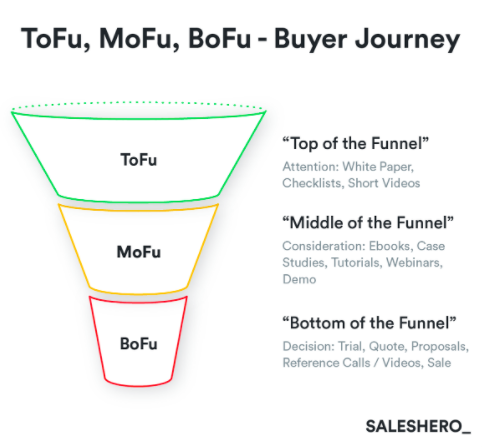
The top of the funnel is the awareness stage, where content is usually used to grab a customer’s attention. The middle of the funnel is the consideration stage, where the prospect has demonstrated they have a problem your product can solve. Finally, the bottom of the funnel is the decision stage, where the prospect is nearing a decision on whether or not to purchase.
But knowing these states is not enough for your go to market strategy.
What are their behaviours along the way? Which marketing channels do they use at each stage? What questions do they ask at each stage?
By knowing what’s going on at each stage and what buyers are thinking at each stage, you can work out exactly how to focus your marketing efforts (and budget!) for the best results.
The chart below offers a more detailed example of what each stage of the journey looks like:
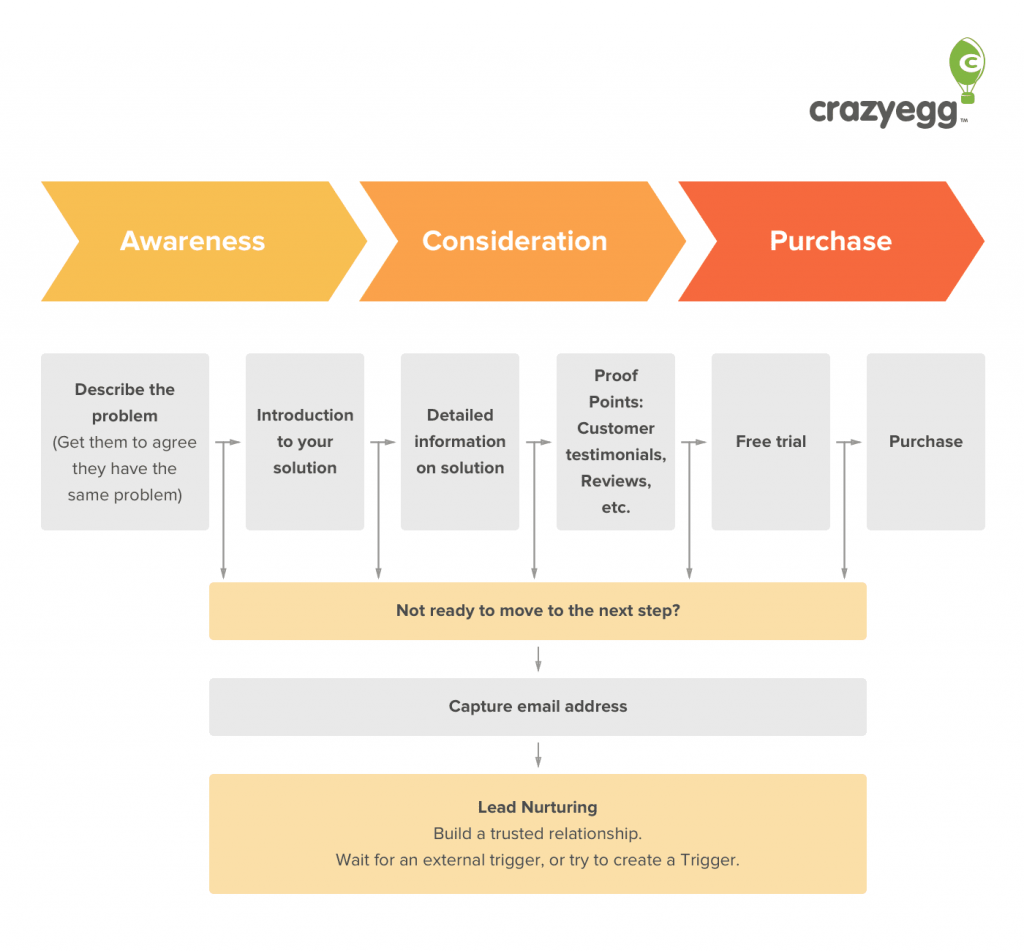
Once a lead reaches the decision stage, the sales team takes over and the lead enters the sales funnel.
The stages of the sales cycle are as follows:
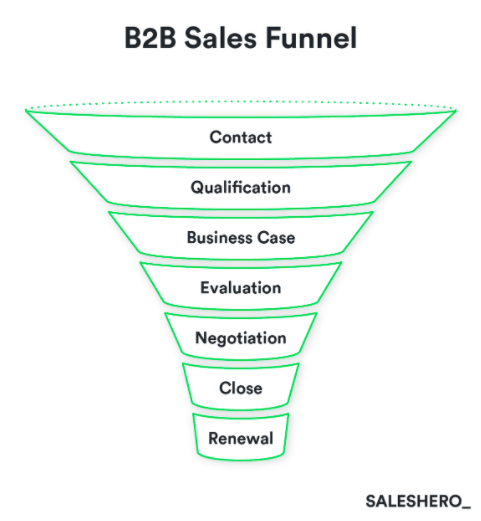
Phase 3. Develop your marketing strategy
Now you’re ready to dive into the tactics crucial for developing a successful go to market strategy.
Let’s assume you already have a distribution strategy (like eCommerce) outlining how customers will purchase your product or service.
Now you need to fill your sales pipeline by grabbing the attention of your target audience.
This is where all your research on buyers and the buyer journey pays off!
There are generally four go to market sales strategies – each one catering to a different product and business model.
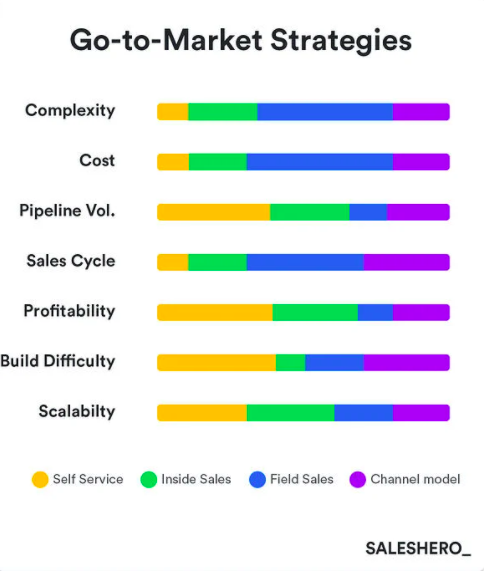
1. Self service model
The self service model is when a customer makes a purchase on their own. This model is usually seen with B2C purchases and works best for simple products with a low cost point and high volume of sales.
2. Inside sales model
The inside sales model is when a prospect needs to be guided by a sales rep to convert into a deal. This model is typically used with products of medium complexity and price.
3. Field sales model
The field sales business model is when you have a full sales organisation that closes enterprise deals. This model typically works with more complex products that have higher price points.
4. Channel model model
Finally, the channel model uses an outside agency or partner to sell your product for you. Since you don’t need to pay a sales team of your own, this model is considerably more affordable.
Ultimately, all of these strategies function to build brand awareness and demand generation using either inbound or outbound marketing (or a combination of the two).
Inbound is where BUYERS discover your brand through your marketing efforts, and then they reach out to you. On the other hand, outbound is typically when YOU contact a lead. That could be sending emails, phoning or gathering leads at conferences.
Here’s what that might look like in reality:
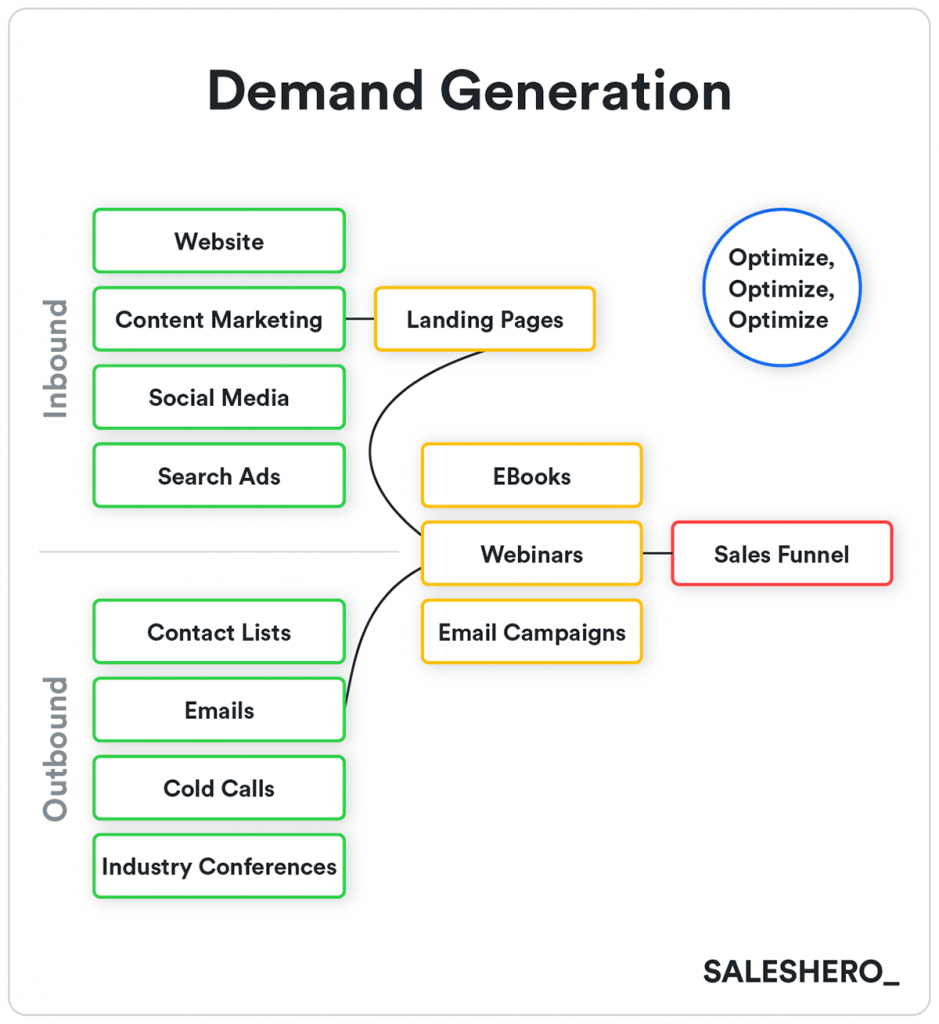
Most often, inbound and outbound work in sync within companies.
Today, we’re focusing largely on inbound tactics because it’s a longer term, higher ROI, and more scalable option.
What inbound tactics should you use in a go to market strategy?
1. Nail your SEO
When you’re ready to go to market, search engine optimisation needs to be at the top of your list.
Why?
Let’s put it this way:
85% of people use Google to research products when making shopping decisions.
The numbers also show:
61% of B2B buyers start their research with search engines.
How does SEO work?
By helping you build rankings and visibility.
Rankings are what most people focus on when they think about SEO.
This is where your website ranks in search engine results for the keywords you target.
Visibility goes a step further. It’s about how prominent you are in the search engine results pages (SERPS). It takes into account your rankings, as well as local search results, PPC ads, Google Shopping placement, and other things.
We know starting on SEO can be daunting. So head over to our Ultimate SEO Checklist to see what’s involved.
2. Create killer content
A killer content marketing strategy is absolutely crucial to your go to market strategy
If there’s one thing you’ll find at the heart of every successful marketing campaign that rakes in leads, it’s incredible content that resonates with the right people.
Why?
First, optimised content drives organic traffic to your website – every new post provides something extra for Google to index and rank in search engine results.
Content helps you get in front of your ideal customers. Especially when you focus your content around the keywords and topics that your potential customers are searching for.
Each content piece also provides an opportunity to drive leads further down your funnel towards being customers. If you can prove that you’re adding value to their lives, they’ll want to know more.
AND great quality content propels your brand’s credibility.
You earn backlinks, mentions, shares – all those trust signals that Google LOVES. Use these tools to bring your content strategy to life.
3. Invest in PPC ads
Paid social and search ads are a stellar way to get in front of your target audience, FAST.
Invest in the right ads, and you can even improve brand awareness by as much as 80%.
Impressive stuff.
Two main types of PPC ads should be in your go to market strategy:
- Search Ads
- Social Ads
Let’s start with search ads.
Google Ads (formerly AdWords) is the most popular search advertising platform and for a good reason.
After all, Google now commands 90% of the search market share.
But does it work?
Put it this way, 79% of marketers say PPC is hugely beneficial for their business.
Do you think they’d invest more in PPC if it didn’t work?
Now let’s talk about social ads.
Facebook Ads are a great place to start for any business because they are designed to help you achieve specific goals:
- Awareness: Build brand awareness or increase reach.
- Consideration: Send traffic to your website, increase engagement, encourage app installs or video views, lead generation, or encourage people to get in touch on Facebook Messenger.
- Conversion: Create online conversions, make catalogue sales, or drive foot traffic to offline stores.
The one you’re most interested in for your go to market strategy is AWARENESS.
But don’t rule out the other goals for long-term success.
Aside from the vast number of people who use Facebook (2.7 billion monthly users!), the targeting capabilities of its advertising platform are out of this world.
Quite frankly, it doesn’t get much more targeted than Facebook Ads.

One of the other brilliant things about social advertising is that there is practically no limit to how much you can scale.
If you want to reach 100,000 people in one day, you can.
Not sure which social channels you should be investing in? Your persona research will reveal where your dream customers are spending their time. In the early days of your business, make sure to focus on one or two channels.
But wait, there’s more!
Don’t even think about doing SEO, paid search or content without these digital marketing tools.
Over to you
There you have it – all of the most vital elements to craft the ultimate go to market strategy.
With all of the above, you should be able to put together a comprehensive go to strategy that will help you break into whatever market you’re after – and make a splash in no time.
To delve into more detail on the HOW section of your go to market plan, download your free Digital Marketing Game Plan.
Written by world-leading marketing experts, this eBook provides all the proven insights, templates, techniques and examples on how to accelerate revenue-shifting results with digital marketing.
Don’t go to market without it! Download your eBook now.









